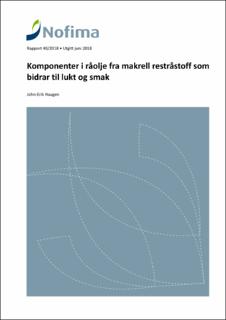| dc.contributor.author | Haugen, John-Erik | |
| dc.date.accessioned | 2020-05-26T07:51:27Z | |
| dc.date.available | 2020-05-26T07:51:27Z | |
| dc.date.created | 2020-05-20T13:18:07Z | |
| dc.date.issued | 2018 | |
| dc.identifier.isbn | 978-82-8296-641-2 | |
| dc.identifier.uri | https://hdl.handle.net/11250/2655540 | |
| dc.description.abstract | Det er analysert flyktige forbindelser i råolje fra makrell restråstoff for å påvise komponenter som kan bidra til lukt og smak i råoljen. De fleste av de påviste stoffene, bortsett fra noen av hydrokarbonene, er luktaktive stoffer, har ulik luktkarakter, og som til sammen vil bidra til lukt og smak av råoljen. Men pga manglende data på empiriske luktterksler i olje/fettfase av mange av de påviste forbindelsene, har det ikke latt seg gjøre å foreta en kvantifisering av luktverdier for alle forbindelsene for å komme frem til de viktigste aromakomponentene i oljen. Med utgangspunkt i de målte konsentrasjoner, fettløselighet til stoffene, eksisterende luktterskler og litteraturdata på tilsvarende flyktig forbindelse påvist i marine råoljer, kan vi konkludere at det vil være aldehydene og syrene som vil bidra mest til lukt og smak av råoljen. Av aldehydene var det 2-propenal og butanal som hadde de høyeste luktverdiene, etterfulgt av heksanal, tr,2-pentenal, oktanal, 2-butenal og tr, cis-2,4-heptadienal. Ved bruk av headspace-GC/MS ble det funnet mest hydrokarboner (41,3 %), derav flest enumettede hydrokarboner, alkoholer (17,2 %), syrer (15,3 %), aldehyder (9,3 %), sulfider/tioler (8 %), ketoner (2,8 %), furaner (1,8 %), aromater (2,1 %,) og 1,9 % andre forbindelser der 3 forbindelser ikke lot seg identifisere. 18 komponenter med høyest konsentrasjon er gjengitt i Figur 2 og utgjorde hele 75 % av total konsentrasjonen flyktige forbindelser målt. Høyest forekomst ble funnet for 2,4,6,10-pentadekan, og utgjorde 33 % av totalkonsentrasjonen flyktige forbindelser. Deretter følger dimetyldisulfid, 2,4-dimetyl-1,3-pentadien, 1-butanol, 4-metyl-pentansyre og cis, cis-3,5-oktadien. De fleste hydrokarboner, aldehyder, ketoner, syrer (C2-C5), furaner og enkelte av alkoholene er sekundære oksidasjonsprodukter fra peroksidering av de flerumettede omega-3 og omega-6 fettsyrene som finnes i oljen. I tillegg kan noen av de flyktige syrene også stamme fra bakterievekst i råstoffet, som også sulfidene kan indikere, som dannes fra både bakteriell nedbrytning av svovelholdige aminosyrer i råstoffet eller termisk kjemiske reaksjoner under råstoffbehandlingen. Flere av de påviste esterne kan også være bakterielle sekundære metabolitter. Typiske markører for lipid oksidasjon i marine oljer ble funnet, som propanal, 1-penten-3-ol, 1-penten-3-on, tr tr-heptadienal og 2-etylfuran. | |
| dc.description.abstract | Volatile compounds in crude oil from mackerel residue have been analyzed to detect components that can contribute to odor and taste in the crude oil. Most of the detected substances, with the exception of some of the hydrocarbons, are odoriferous, have different odor thresholds, and which together will contribute to the smell and taste of the crude oil. However, due to lack of data on empirical oil phase odor threshold data of many of the compounds detected, it has not been possible to quantify odor activity values for all the compounds to arrive at the most important aroma components of the oil. Based on the measured concentrations, fat solubility of the substances, existing odor thresholds and literature data on the corresponding volatile compounds detected in marine crude oils, we can conclude that it will be the aldehydes and acids that will contribute most to the smell and taste of the crude oil. Of the aldehydes, 2-propenal and butanal had the highest odor activity values, followed by hexanal, tr, 2-pentenal, octanal, 2-butenal and tr, cis-2,4-heptadienal. Using headspace-GC/MS, it was found that most hydrocarbons (41.3%) were found, most of which were monounsaturated hydrocarbons, alcohols (17.2%), acids (15.3%), aldehydes (9.3%), sulphides/thiols (8%), ketones (2.8%), furans (1.8%), aromatics (2.1%), and 1.9% other compounds where 3 compounds were not identifiable. 18 components with the highest concentration accounted for as much as 75% of the total concentration of volatiles measured. The highest amount was found for 2,4,6,10-pentadecane, accounting for 33% of the total volatiles. Next comes dimethyl disulphide, 2,4-dimethyl-1,3-pentadiene, 1-butanol, 4-methyl-pentanoic acid and cis, cis-3,5-octadiene. Most of the hydrocarbons, aldehydes, ketones, acids (C2-C5), furans and some of the alcohols were secondary oxidation products from the peroxidation of the polyunsaturated omega-3 and omega-6 fatty acids contained in the oil. In addition, some of the volatile acids may also result from bacterial growth in the feedstock, which may also indicate the sulfides, which are formed from both bacterial degradation of sulfur-containing amino acids in the raw material or thermal chemical reactions during raw material processing. Several of the detected esters may also be bacterial secondary metabolites. Typical markers for lipid oxidation in marine oils were found, such as propanal, 1-penten-3-ol, 1-penten-3-one, tr tr-heptadienal and 2-ethylfuran. | |
| dc.language.iso | mis | |
| dc.publisher | Nofima AS | |
| dc.relation.ispartof | Nofima rapportserie | |
| dc.relation.ispartofseries | Nofima rapportserie | |
| dc.relation.uri | https://nofimaas.sharepoint.com/:b:/s/public/ETmEP6pJkelImloNrLyikMEBadDv8NP72ePqjJuik9Ft-g | |
| dc.title | Komponenter i råolje fra makrell restråstoff som bidrar til lukt og smak | |
| dc.title.alternative | Components in crude oil from mackerel that contribute odor and taste | |
| dc.type | Research report | |
| dc.description.version | publishedVersion | |
| dc.source.pagenumber | 15 | |
| dc.source.issue | 40/2018 | |
| dc.identifier.cristin | 1811913 | |
| dc.relation.project | Fiskeri- og havbruksnæringens forskningsfinansiering: 901370 | |
| dc.relation.project | Nofima AS: 12191 | |
| cristin.ispublished | true | |
| cristin.fulltext | original | |
